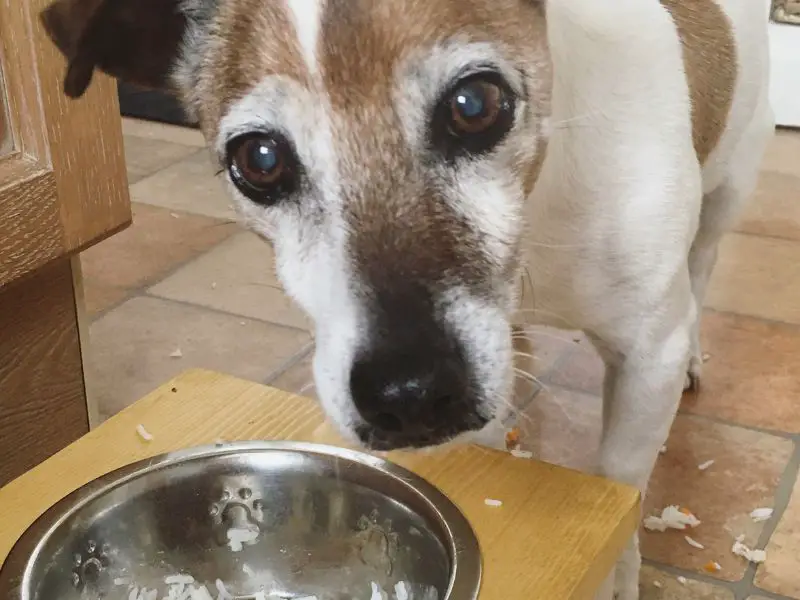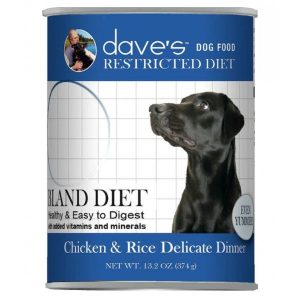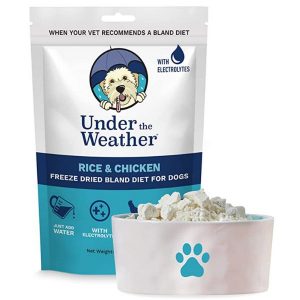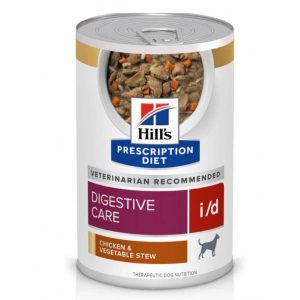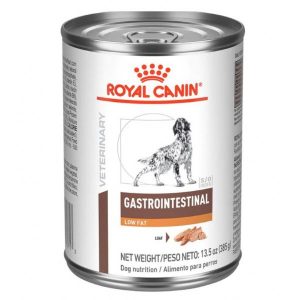If your dog has had loose stools or an intestinal upset, you’ve probably heard that you should feed him a diet of chicken and rice. However, you need to answer a few key questions:
- How much chicken and rice should you feed your dog?
- When is it appropriate to feed this diet?
- How long should you feed your dog chicken and rice?
Even too much of a good thing can, unfortunately, lead to health problems for your beloved dog.
I know that feeding and caring for a sick canine is stressful. Over the years, many of my dogs have had various illnesses resulting in loose stools.
So, in this article, I’ll discuss when and how much to feed chicken and rice to your dog. And I’ll set forth parameters regarding how long such a diet should be provided to your canine best friend.
I’ll also provide other alternatives you can provide to your pup when he’s not feeling up to snuff.
And remember not to give your dog treats that could derail your program to get his digestive system back on the right track.
FULL DISCLOSURE: We are not veterinarians. This article is for entertainment purposes only. If you ever have questions about your dogs health please consult your vet for their expert opinion.
When You Should Feed Chicken and Rice to Your Dog
If your dog isn’t feeling well and has loose stools or vomits, you should contact your vet about what to do.
Depending on how severe and frequently the symptoms occur, your vet may tell you to feed a diet of chicken and rice to your dog for a few days.
Your vet may even instruct you to first have your dog fast prior to putting him on a bland diet. Also check with your vet about whether your dog should have water during a day of fasting, as he may dehydrate without water.
A bland diet can give your dog’s intestinal tract and stomach the rest they need to recuperate.
There are certain times vets recommend putting your pup on a chicken-and-rice diet for a few days. These include:
- A bout of diarrhea without blood or a dark tarry appearance
- Soft, watery stools
- Vomiting for six or more hours
- Mild stomach upset
- Gas
- Constipation
- Nausea
- Loss of appetite
- Recovery from surgery or serious illness
This is a short-term diet for a couple of days, as directed by your vet. It’s not nutritionally complete and, if given as a regular diet, can lead to malnourishment and health issues.
If your pup has severe diarrhea or vomiting that lasts more than 24 hours, he may rapidly dehydrate, especially if he’s small, very young, a senior, or otherwise has health issues.
If so, you should take your pup to the vet because these can be symptoms of other illnesses, including intestinal parasites. If you need to take your dog in, your vet will probably also ask you to bring a stool sample to examine.
If in doubt about your dog’s illness, err on the side of caution and take him in to see the vet.
The Benefits of Chicken and Rice
As long as I can recall, people have given their dogs chicken and rice when they’re sick.
When the first dog I had as an adult, a Shih Tzu named Cuddles, had diarrhea, the vet “prescribed” a diet of chicken and rice for about a week.
Now, vets usually say to give this for a couple of days only. Luckily, Cuddles didn’t have any major health issues. The loose stools were probably caused by a new treat I gave her.
Within a week, she was back to herself and we were transitioning back to her regular food.
Why do vets recommend chicken and rice?
- They’re easy to digest
- The combination helps stimulate your dog’s appetite
- Rice promotes the growth of good bacteria, helping to regulate bowel movements
- Rice is an excellent source of carbohydrates, vitamins, and minerals
- Rice has vitamins D and G, which are important for heart health
- Rice has calcium, iron, and riboflavin
- The starch in rice helps stimulate your dog’s appetite
- Chicken is high in protein, which is an important source of energy
- Chicken is rich in Omega 6 fatty acids, which promote healthy skin and coat
- Chicken has essential amino acids
- Chicken has glucosamine, which is essential for healthy bones
What Type of Rice Should You Use?
Although brown rice has even more nutrients than white rice does, white rice is what’s recommended when feeding a chicken-and-rice diet for a few days.
It’s easier to digest than brown rice is. It’s also more likely to stimulate your dog’s appetite because of its high starch content.
However, brown rice is recommended when feeding rice as a part of your dog’s regular diet. But remember if you’re developing a diet yourself for your dog, consult a qualified canine nutritionist to ensure that the diet’s nutritionally complete.
White rice is not recommended long-term because of its relatively high glycemic level, which can potentially lead to adverse health consequences such as diabetes.
What Type of Chicken Should You Use?
If you’re feeding the chicken-and-rice diet because your dog doesn’t feel well, it’s generally best to feed white meat, which is lower in fat than dark meat is. Also, don’t use the skin, which is high in fat.
And make sure to thoroughly debone the chicken because chicken bones can harm and even be deadly to dogs.
I use boneless, skinless chicken breasts. I can easily buy them at the supermarket and usually have some in the freezer just in case. I even keep canned white-meat chicken to use in a pinch.
Recently, my sheltie Gracie was chewing part of a digestible chew and became ill. She vomited and had extreme diarrhea.
It was so bad that I took her to the vet. After getting some prescribed meds, the vet put her on a chicken-and-rice diet for a few days.
Between the meds and the bland diet, she recovered and was her spunky, adorable self in a few days. And we transitioned her back to her regular food over the following week.
Needless to say, I won’t be giving Gracie that chew again.
How To Prepare the Chicken and Rice
Boil the pieces of chicken. You can use boneless, skinless chicken breasts with the fat removed.
You can even purchase the plain, raw chicken breasts can be cut into tenders when you buy them. Make sure to use plain, raw chicken not any coated in any type of breading or seasoning.
Just be sure to cook them thoroughly and that there’s no pink in the middle. You don’t want to risk salmonella.
Drain the water and cut the chicken into bite-sized pieces after it cools.
You don’t want the pieces to be too large or a dog can choke on them or not digest them well.
Boil the rice in water. Alternatively, you can choose to boil it in the chicken broth from the chicken that you boiled. Make sure that you drain off any fat first if there is any.
Don’t use any fats such as oil or butter when preparing the chicken or the rice. Also, don’t use any spices or seasonings as they may irritate your dog. Some are even toxic.
Mix the chicken and rice mixture, one part chicken to two parts rice. So, for each cup, there should be one-third cup chicken to two-thirds of a cup rice.
Before serving the mixture to your dog, make sure that it’s thoroughly cooled down to room temperature.
If it’s too hot, it could burn your dog’s mouth, tongue, and throat. And don’t serve it ice cold either or it could upset your dog.
Of course, don’t leave the mixture out too long so that it doesn’t spoil. Put whatever you’re not serving at the time in the refrigerator or freezer.
If you choose to make a large amount, it will keep in the refrigerator for two to three days and in the freezer for up to two months.
How Much Chicken and Rice Should You Feed Your Dog By Weight
The chicken-and-rice mix may have a higher caloric count than your dog’s regular food does. So you need to be sure to give him the correct amount–which might be less than you normally give him.
Generally, depending on their activity level, dogs require between 25 and 30 calories per day per pound of body weight.
A standard cup of chicken and rice prepared as described above contains between 350 and 400 calories.
So, when shih tzu Cuddles needed to have chicken and rice for a couple of days, she was given the smaller amount because she was only 14 pounds.
As a relatively inactive dog, she would require about 25 calories times 14 pounds per day, equaling 350 calories per day.
So about one cup of the mix was plenty, served in small portions about four times per day.
Ask your vet regarding how often to feed the mix. Many vets advise to break the amount into small meals throughout the day as they’re easier to digest.
Chart Regarding Amount To Feed Your Dog By Weight
| Dog Weight | Amount of Chicken & Rice |
|---|---|
| 10 lbs | .75 Cups |
| 20 lbs | 1.5 Cups |
| 30 lbs | 2.25 Cups |
| 40 lbs | 3 Cups |
| 50 lbs | 3.75 Cups |
| 60 lbs | 4.5 Cups |
| 70 lbs | 5.25 Cups |
| 80 lbs | 6 Cups |
Always check with your vet first regarding how much and how often to feed your dog any new food, including the chicken-and-rice combo. The above guidelines are approximations.
How Often Should You Feed Chicken and Rice?
Vets often instruct people to feed their dogs the mix for about three days at most. Although there are exceptions, feeding the diet for too long can have ill effects because it’s not nutritionally balanced. It’s just meant to help your pup during a short time when he’s ill.
Although you may usually split your dog’s meal into two meals a day, your vet may instruct you to split the temporary chicken-and-rice meal into four to six meals per day.
Doing so limits excessive muscular contractions of the stomach, helping to calm down the vomiting or diarrhea your dog suffers from.
How To Phase Back Your Dog’s Regular Food
Your vet will probably instruct you to watch if your dog seems to be benefitting from the chicken-and-rice diet. And she may tell you to make an appointment if not.
Or if your dog’s symptoms are resolving, she may say to begin phasing in your dog’s regular food.
You shouldn’t just switch back immediately to his regular food all at once or you may wind up with your pup regressing and having diarrhea, vomiting, inappetence, and the other symptoms that he had.
After all, dogs have sensitive stomachs.
You can start by adding about 25 percent of his regular food with 75 percent of the chicken and rice. Over about a week, gradually work up to 100 percent of his regular diet.
Of course, if you see that your dog isn’t hungry or has any of the symptoms that caused you to put him on the chicken-and-rice diet, contact your vet.
Alternatives and Additions to Chicken and Rice
There are alternatives that you may use instead of chicken and rice when your dog is ill or recovering from surgery or an illness.
Of course, check with your vet which temporary diet would work best for your dog and his symptoms.
Sometimes a protein other than chicken is substituted because chicken is a common allergen to dogs. And, if your dog is constipated and not suffering from diarrhea, you may want to choose something rather than rice as part of the temporary diet.
1. Pumpkin
Pumpkin is a bland food containing a lot of fiber. The fiber helps regulate a dog’s digestive system.
As a bonus, it’s full of essential vitamins and minerals, including vitamins A, B6, C, and E, niacin, iron, magnesium, phosphorus, potassium, and manganese.
You can cook and mash your own. But I find plain canned pumpkin to be much easier.
Don’t use the pumpkin pie mix that has sugar and seasonings, which can be detrimental to your dog’s health.
If your dog’s constipated, you can add a couple of tablespoons to his chicken and rice mixture.
When I see that my dog’s stools are slightly loose, I add a couple of tablespoons to his regular food for a few days. If there’s no real medical problem, it firms his stools up.
Even when my dogs have no dietary indiscretions, I also use plain canned pumpkin when filling my dog’s Toppls (an enrichment toy).
I use a mix of mainly canned pumpkin with a little plain, fat-free Greek yogurt, and a little jarred sweet potato. So I always keep canned pumpkin on hand.
QUICK RECOMMENDATION: One of the breeders we work with sends home all of her puppies with Weruva Pumpkin Patch Up just in case puppies get an upset stomach. We’ve also used canned pumpkin straight from our grocery store. But as mentioned earlier make sure it’s plain pumpkin with nothing added.
2. Ground beef and rice
If your dog has an allergy to chicken, you might want to try an alternative protein source such as ground beef.
Also, some dogs who have temporarily lost their appetite can be tempted to eat beef rather than chicken.
Some vets recommend lean ground beef. Make sure that you boil it so that it’s cooked well and drain off any fat before mixing it with the rice.
Once again, you can do a one-third beef mix to two-third rice mixture.
Years ago, my sheltie Duffy’s vet recommended ground beef and rice when he had loose stools.
The mix really enticed him to eat. After a few days, his stools were back to normal.
3. Cottage cheese
Fat-free or low-fat cottage cheese contains protein. So, if there’s a reason, such as a food allergy to chicken, you may want to add cottage cheese to the rice instead of chicken to the temporary diet.
Don’t use cottage cheese if your dog is lactose intolerant. Feeding a small amount may help firm stools whereas too much can exacerbate diarrhea.
4. Bone Broth
This can help restore your dog’s appetite and keep him hydrated. It’s also good for dogs who can’t tolerate solid food at the time.
You can make your own or buy it ready-made. If you make your own, don’t give your dog the bones, which become brittle and break into dangerous pieces.
To prepare and store bone broth:
- Fill a crockpot with beef marrow bones or bones with lots of joints such as chicken legs
- Cover the bones with three inches of water and cook on low for 24 hours
- Remove the bones and throw them out where your dog can’t reach them. Cool the broth in the refrigerator for two or three hours
- Scoop off the fat that rises to the top and safely dispose of it
- If storing the broth in the refrigerator, heat up the required quantity to liquify the jelly-like substance that forms on the top. Just be sure that the broth is cool before feeding it to your dog.
5. Probiotics
Your vet may instruct you to add a probiotic such as Fortiflora to your dog’s chicken and rice mixture or even to his regular diet.
Probiotics are microorganisms that help stop bad or undesirable bacteria from overgrowing in the gut.
It increases the amount of beneficial bacteria in a dog’s gut and is a powder that can easily be sprinkled over your dog’s food.
My dogs’ vet routinely recommends adding this when one of my dogs has a dietary indiscretion.
It has really helped a number of times when one of my dogs has an upset tummy.
6. Baby food
Baby food is designed to be easy to digest. So the meat-based formulas, Stage II variety, can safely be fed to your dog.
This is an option especially if your dog has a chicken allergy. Use just the meat variety that isn’t mixed with other ingredients such as spices or seasonings.
IN OUR EXPERIENCE: When Linus had congestive heart failure and stopped eating because of his meds our vet recommended we start feeding him baby food.
7. Carrots
Sometimes carrots may be recommended for dogs who have a mild case of diarrhea because they increase the bulk in his diet and absorb excess water.
They’re nutrient and vitamin rich. They’re high in fiber, which aids in digestion and helps maintain regular fecal consistency.
But don’t feed too much or the added sugars can cause intestinal upset and diarrhea. And too much fiber can also cause flatulence.
Make sure to boil and mash the carrots first if used as a temporary aid for diarrhea.
My dogs love small pieces of carrots a few times a week as a special treat.
Commercial Diets
If you’d rather purchase a diet formulated for when your pup is ill, there are choices for a bland diet that may help in your dog’s recovery.
Dave’s Dog Food Restricted Bland Chicken & Rice Canned Food
This food is nutritionally balanced, unlike the chicken-and-rice diet and was formulated for dogs with allergies or food sensitivities.
It’s also for dogs prone to stomach upset and can help calm a dog’s stomach. It comes two formulas: chicken and lamb.
Under the Weather Rice and Chicken Freeze-Dried Food
This food comes in various varieties with rice; chicken; chicken with bone broth; chicken and pumpkin; hamburger and sweet potato; hamburger and bone broth; and turkey and sweet potato.
They require some preparation. The formula you choose needs to be boiled in water for 15 to 20 minutes, which must be cooled before your dog can eat it.
Prescription Diets
Your vet may even prescribe a prescription food to help your dog with his diarrhea or inappetence.
Hill’s Prescription Diet, Digestive Care, I/D
Hill’s Prescription Diet, Digestive Care, I/D can help settle digestive upsets, promote regular bowel movements, and support your dog’s digestive health.
Royal Canin Veterinary Diet, Gastrointestinal, Lowfat
Royal Canin Veterinary Diet, Gastrointestinal, Lowfat was formulated for long- or short-term digestive sensitivities. The formula promotes digestive health and optimal stool quality.
A friend of mine with a yorkie named Bella who had bouts of diarrhea was first told to feed her dog chicken and rice. It seemed to work in the short term.
But, because of the dog’s long-term problems with her stomach was eventually put on the prescription diet, which firmed up Bella’s stools.
FAQs
My dog doesn’t want to eat his regular food but loves treats, including pieces of chicken. Can I feed him chicken and rice long-term?
No! Chicken and rice is meant to be fed for a few days in order to help a dog with mild diarrhea or vomiting.
It’s not nutritionally balanced and can therefore be harmful if fed long-term.
If your dog isn’t ill and his regular food is appropriate for him, you might try to put a purchased food topper on it or switch to another protein source that he finds more enticing.
My dog has diarrhea. Should I use a purchased pre-cooked roaster chicken when I make my dog’s chicken-and-rice mix?
No. It would probably contain too much fat (skin and internal fat) which may upset your dog.
Boiling boneless, skinless pieces of white chicken meat, draining the fat, is better to mix with cooked white rice.
My vet said that I should give my dog chicken and rice for a few days. Is brown rice best?
Generally, white rice is best short-term. It’s more digestible than brown rice and the starch in white rice tends to stimulate a dog’s appetite more than brown rice does.
Final Thoughts
If your dog has intestinal upsets or loose stools, there are home-made options to help get your dog back on the right track and feeling better.
Whether you feed a chicken-and-rice combo or another similar temporary diet, it’s important to know how much to feed.
These diets aren’t meant to be used long-term because they aren’t nutritionally balanced. Always check with your vet regarding what’s appropriate for your dog’s condition.
And a vet visit is in order if your dog is in pain or has severe symptoms. There are also prescription diets your vet may prescribe short or long-term.
